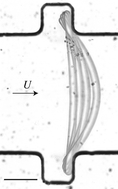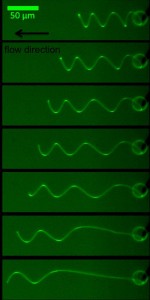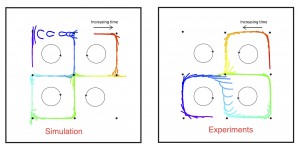Soft Matter, 2013,9, 9103-9110
We outline a simple techniq ue to engineer monodisperse, superparamagnetic, micron-sized prisms of arbitrary cross-section and large magnetic susceptibility. The fabrication process allows pre-positioning of the particles that introduces another lever to guide self-assembly. In this method, a dispersion of magnetic colloids in a UV-curable monomer is molded in PDMS wells and subsequently reticulated. High homogeneous magnetic content is achieved by preventing colloidal aggregation through careful choice of the colloid and monomer. Additionally, on their removal from the PDMS molds, the relative position of the magnetic particles is conserved: they are extracted as arrays whose patterns are set by the PDMS mold. This novel method therefore offers unique control of the self-assembly of specific ‘higher order’ structures mediated by dipolar interactions and directed by the geometry and initial positioning of the particles. This is also a promising approach to develop devices with complex responses to external fields.
ue to engineer monodisperse, superparamagnetic, micron-sized prisms of arbitrary cross-section and large magnetic susceptibility. The fabrication process allows pre-positioning of the particles that introduces another lever to guide self-assembly. In this method, a dispersion of magnetic colloids in a UV-curable monomer is molded in PDMS wells and subsequently reticulated. High homogeneous magnetic content is achieved by preventing colloidal aggregation through careful choice of the colloid and monomer. Additionally, on their removal from the PDMS molds, the relative position of the magnetic particles is conserved: they are extracted as arrays whose patterns are set by the PDMS mold. This novel method therefore offers unique control of the self-assembly of specific ‘higher order’ structures mediated by dipolar interactions and directed by the geometry and initial positioning of the particles. This is also a promising approach to develop devices with complex responses to external fields.

 Pham, J.T., Morozov, A., Crosby, A.J., Lindner, A. & du Roure, O.
Pham, J.T., Morozov, A., Crosby, A.J., Lindner, A. & du Roure, O. Quennouz N., Shelley M.J., du Roure, O. & Lindner, A.
Quennouz N., Shelley M.J., du Roure, O. & Lindner, A. Home
Home